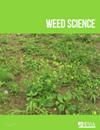巴西的光滑猪笼草(Amaranthus hybridus)和对草甘膦具有抗性的未解决的苋属(Amaranthus spp.)表现出EPSPS TAP-IVS置换
IF 2.5
2区 农林科学
Q2 AGRONOMY
引用次数: 0
摘要
最近几年,巴西南部出现了更多抗草甘膦的平滑猪笼草(Amaranthus hybridus L.)生物型,这些生物型在 5-烯醇-丙酮酰石基铵-3-磷酸合成酶(EPSPS)中出现了三重氨基酸替代 TAP-IVS,这与之前在阿根廷发现的情况相同。其中一些生物型具有平滑猪笼草和红根苋菜(Amaranthus retroflexus L.)的形态特征。本研究旨在通过分子标记鉴定巴西具有 TAP-IVS 替代的抗除草剂苋属物种,并分析这些生物型中 TAP-IVS 替代的来源--花粉介导的基因流(PMGF)的发生情况。通过内部转录间隔序列(ITS)评估了六个生物型,其中两个(AMACHY-S 和 CAMAQ-R)被分子分类为杂交种,四个(AMACRET-S、AMACVI-S、ARRGR-R 和 SAOJER-R)未被分类。有趣的是,所有抗草甘膦生物型(ARRGR-R、SAOJER-R 和 CAMAQ-R)都有 TAP-IVS 取代,且 EPSPS 相对拷贝数增加;但只有 CAMAQ-R 被确认为 A. hybridus。尽管生物型 ARRGR-R 和 SAOJER-R 与 A. hybridus 和绿猪笼草(Amaranthus powellii S. Watson)亲缘关系密切,但它们的物种身份仍无法确定。由于乙酰乳酸合成酶(ALS)574 位的色氨酸被亮氨酸取代,生物型 SAOJER-R 也对 ALS 抑制除草剂具有抗性。杂交种的种内杂交研究对 119 746 株幼苗进行了评估,结果表明杂交频率为 0.09%。相反,在对 111 429 株后代进行筛选后发现,没有出现种间杂交(A. hybridus × 未分类生物型 - AMACVI-S)。未分类的生物型可能来自一个或多个古老的杂交事件,随后独立进化出三重突变。或者,这些生物型可能是由最近的杂交事件进化而来,其发生频率低于我们研究的检测水平。本文章由计算机程序翻译,如有差异,请以英文原文为准。
Smooth pigweed (Amaranthus hybridus) and unresolved Amaranthus spp. from Brazil resistant to glyphosate exhibit the EPSPS TAP-IVS substitution
The presence of glyphosate-resistant smooth pigweed (Amaranthus hybridus L.) biotypes has increased in southern Brazil in the last years, presenting the triple amino acid substitution TAP-IVS in the 5-enol-pyruvylshikimate-3-phosphate synthase (EPSPS), as previously found in Argentina. Some of these biotypes have morphological characteristics of smooth pigweed and redroot amaranth (Amaranthus retroflexus L.). The present study aimed to identify, through molecular markers, the herbicide-resistant species of Amaranthus from Brazil that have the TAP-IVS substitution and to analyze the occurrence of pollen-mediated gene flow (PMGF) as the source of TAP-IVS substitution in these biotypes. Six biotypes were evaluated by the internal transcribed spacer (ITS) sequences, of which two (AMACHY-S and CAMAQ-R) were molecularly classified as A. hybridus, and four (AMACRET-S, AMACVI-S, ARRGR-R, and SAOJER-R) were unclassified. Interestingly, all the glyphosate-resistant biotypes (ARRGR-R, SAOJER-R, and CAMAQ-R) had the TAP-IVS substitution, and an increase in EPSPS relative copy number; however, only CAMAQ-R was confirmed as A. hybridus. Although the biotypes ARRGR-R and SAOJER-R are closely related to A. hybridus and green pigweed (Amaranthus powellii S. Watson), their species identity could not be resolved. The biotype SAOJER-R also was resistant to ALS-inhibiting herbicides due to a tryptophan to leucine substitution at position 574 in acetolactate synthase (ALS). The evaluation of 119,746 seedlings in an intraspecific hybridization study of A. hybridus indicated an outcrossing frequency of 0.09%. In contrast, an absence of interspecific hybridization (A. hybridus × unclassified biotype – AMACVI-S) was found after screening 111,429 offspring. Unclassified biotypes might be derived from one or more ancient hybridization events and subsequently evolved the triple mutation independently. Alternatively, such biotypes could have evolved from recent hybridization events, which occur at a frequency below the level of detection in our study.
求助全文
通过发布文献求助,成功后即可免费获取论文全文。
去求助
来源期刊

Weed Science
农林科学-农艺学
CiteScore
4.60
自引率
12.00%
发文量
64
审稿时长
12-24 weeks
期刊介绍:
Weed Science publishes original research and scholarship in the form of peer-reviewed articles focused on fundamental research directly related to all aspects of weed science in agricultural systems. Topics for Weed Science include:
- the biology and ecology of weeds in agricultural, forestry, aquatic, turf, recreational, rights-of-way and other settings, genetics of weeds
- herbicide resistance, chemistry, biochemistry, physiology and molecular action of herbicides and plant growth regulators used to manage undesirable vegetation
- ecology of cropping and other agricultural systems as they relate to weed management
- biological and ecological aspects of weed control tools including biological agents, and herbicide resistant crops
- effect of weed management on soil, air and water.
 求助内容:
求助内容: 应助结果提醒方式:
应助结果提醒方式:


